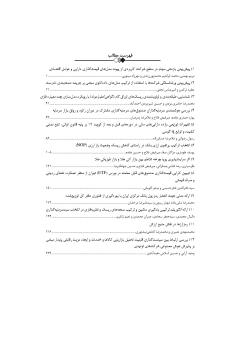پیش بینی بازدهی سهام در سطح شرکت: کاربردی از پیوند مدل های قیمت گذاری دارایی و عوامل اقتصادی
پیش بینی بازدهی سهام در سطح شرکت: کاربردی از پیوند مدل های قیمت گذاری دارایی و عوامل اقتصادی
محورهای موضوعی : بورس اوراق بهادار
مریم بهمنی
1
![]() ,
محمدابراهیم پورزرندی
2
,
محمدابراهیم پورزرندی
2
![]() ,
مهرزد مینویی
3
,
مهرزد مینویی
3
1 - گروه مدیریت صنعتی ، واحد تهران مرکزی ، دانشگاه آزاد اسلامی ، تهران ، ایران
2 - گروه مدیریت صنعتی ، واحد تهران مرکزی ، دانشگاه آزاد اسلامی ، تهران ، ایران
3 - گروه مدیریت صنعتی ، واحد تهران مرکزی ، دانشگاه آزاد اسلامی ، تهران ، ایران
کلید واژه: بازدهی سهام, عوامل اقتصادی, مدل های قیمت گذاری دارایی,
چکیده مقاله :
این تحقیق در راستای پیشبینی بازدهی سهام در سطح شرکت: کاربردی از پیوند مدلهای قیمت-گذاری دارایی و عوامل اقتصادی، در 130 شرکت منتخب پذیرفته شده در بورس اوراق بهادار تهران در بازه زمانی 1391 تا 1398 به انجام رسیده است. در این تحقیق سعی گردیده است تا با تلفیقی از الگوی چند عامله و الگوی پژوهش، جهت پیش بینی عملکرد آتی الگویی پیشنهاد گردد. نتایج نشان داد که 1) ناهنجاریهای در بازده سهام مورد ارزیابی قرار گرفت و با توجه به نتایج به دست آمده مبتنی بر آزمون گیبونز، تنها الگوی مبتنی بر الگوی پیشنهادی پژوهش است که بر خلاف الگوهای چند عامله(تک، سه، چهار و پنج عامله) قادر به تبیین ناهنجاریهای در بازده سهام است. 2) به علت پیچیدگی و در تعارض در روابط بین متغیرهای توضیحی و عملکرد آتی، قدرت تبیین الگوی پیشنهادی پژوهش در پیشبینی ناهنجاریهای در اقلام تعهدی و هزینههای تحقیق و توسعه به ارزش شرکت، ضعیفتر از الگوهای چند عاملی بوده که استفاده از الگوی تلفیقی پژوهش(استفاده از سودآوری، بازده مبتنی بر پایینترین و بالاترین قیمت)، الگوی پیشنهادی قدرت تبیین بهتری در این زمینه نشان داده است.
This research has been done in order to predict stock returns at the company level: an application of linking asset pricing models and economic factors, in 130 selected companies admitted to the Tehran Stock Exchange between 2011 and 2018. In this research, an attempt has been made to propose a model for predicting future performance by combining a multi-factor model and a research model. The results showed that 1) anomalies in stock returns were evaluated and according to the results obtained based on the Gibbons test, it is the only model based on the proposed research model that is able to explain anomalies in stock returns unlike the multi-factor models (single, three, four and five agent) 2) Due to the complexity and conflict in the relationship between explanatory variables and future performance, the power to explain the proposed research model in predicting anomalies in accruals and research and development costs to the value of the company, is weaker than multifactorial models that use of The integrated model of research (using profitability, returns based on the lowest and highest price) as well as the proposed model have shown a better explanatory power in this field.
_|1) Ahmadkhani, Massoud, Abdul Rahimian, Mohammad Hossein, Mirjafari Ardakani, Seyed Ahmad, (2018). Investigating the relationship between investment factors and performance and stock returns of companies listed on the Tehran Stock Exchange, Shabak, No. 44, pp. 26-33
2) Azhdari, Fatemeh, Rahnama Roudpashti, Fereydoun, Hamidian, Mohsen, Jafari, Sayedah Mehbobeh, Baghani, Ali, (2018). Selection of stock portfolio for investment and identification of top companies with L limit method and using machine learning method, financial management strategy, published online from July 16, 2018.
3) Chen, Tai-liang, and Feng-yu Chen. 2016. An intelligent pattern recognition model for supporting investment decisions in stock market. Information Sciences 346: 261–74
4) Di Persio, Luca, and Oleksandr Honchar. 2017. Recurrent Neural Networks Approach to the Financial Forecast of Google Assets. International Journal of Mathematics and Computers in simulation 11: 7–13.
5) Ghosh, I., & Chaudhuri, T. D. (2021). FEB-stacking and FEB-DNN models for stock trend prediction: a performance analysis for pre and post covid-19 periods. Decision Making: Applications in Management and Engineering, 4(1), 51-84.
6) Hossain, Mohammad Asiful, Rezaul Karim, Ruppa K. Thulasiram, Neil D. B. Bruce, and Yang Wang. 2021. Hybrid Deep Learning Model for Stock Price Prediction. Paper presented at the 2018 IEEE Symposium Series on Computational Intelligence (SSCI), Bangalore, India, November 18–21.
7) Kim, Sang, Hee Soo Lee, Hanjun Ko, Seung Hwan Jeong, Hyun Woo Byun, and Kyong Joo Oh. 2018. Pattern Matching Trading System Based on the Dynamic Time Warping Algorithm. Sustainability 10: 4641.
8) Lev, Dongdong, Shuhan Yuan, Meizi Li, and Yang Xiang. 2019. An Empirical Study of Machine Learning Algorithms for Stock Daily Trading Strategy. Mathematical Problems in Engineering.
9) Olson, D., & Mossman, C. (2003). Neural network forecasts of Canadian stock returns using accounting ratios. International Journal of Forecasting, 19(3) , 453–466.
10) Pai, P.-F., & Lin, C. –S. (2005). A Hybrid ARIMA and support vector machines model in stock price forecasting. Omega, 33(6), 497–505.
11) Roy, R., & Shijin, S. (2018). A six-factor asset pricing model. Borsa Istanbul Review, 18(3), 205-217.
12) Seng, Jia-Lang, and Hsiao-Fang Yang. 2021. The association between stock price volatility and financial news—A sentiment analysis approach. Kybernetes 46: 1341–65.
13) Shah, D., Isah, H., & Zulkernine, F. (2021). Stock market analysis: A review and taxonomy of prediction techniques. International Journal of Financial Studies, 7(2), 26.
14) Xu, Yumo, and Shay B. Cohen. 2018. Stock movement prediction from tweets and historical prices. Paper Presented at the 56th Annual Meeting of the Association for Computational Linguistics, Melbourne, Australia, July 15–20.
15) Yang, Bing, Zi-Jia Gong, and Wenqi Yang. 2017. Stock Market Index Prediction Using Deep Neural Network Ensemble. Paper Presented at the 2017 36th Chinese Control Conference (CCC), Dalian, China, July 26–28.
16) Zhang, Jing, Shicheng Cui, Yan Xu, Qianmu Li, and Tao Li. 2018. A novel data-driven stock price trend prediction system. Expert Systems with Applications 97: 60–69.
17) Zorin, A., & Borisov, A. (2002). Modelling Riga Stock Exchange Index using neural networks. http://overcite.lcs.mit.edu/cache/papers/cs/26702/http:zSzzSzdssg. cs.rtu.lvzSzenzSzpublicationszSz.zSz.zSzdownloadzSzpublicationszSz2002zSzZorins-RA-2002.pdf/zorin02modelling.pdf.
|_


